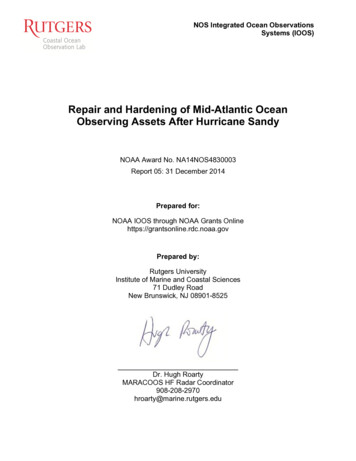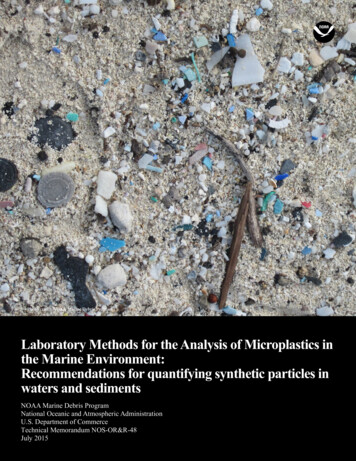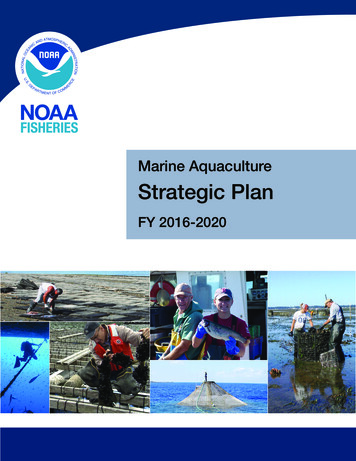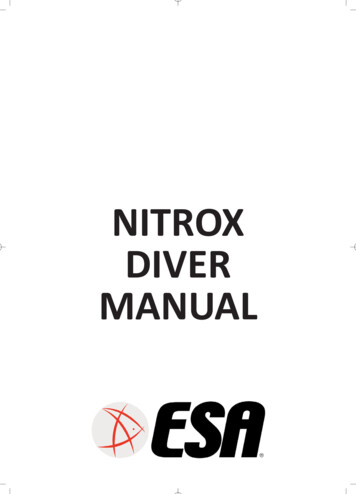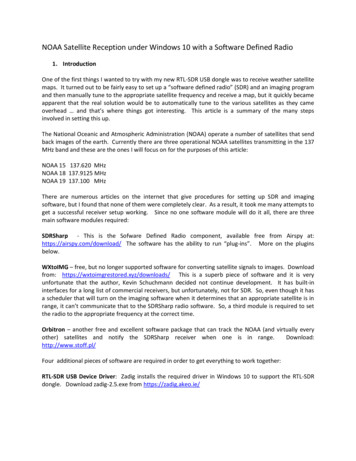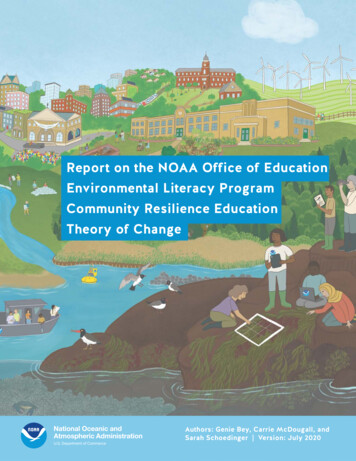
Transcription
Report on the NOAA Office of EducationEnvironmental Literacy ProgramCommunity Resilience EducationTheory of ChangeAuthors: Genie Bey, Carrie McDougall, andSarah Schoedinger Version: July 2020
ACKNOWLEDGEMENTSThe authors would like to thank everyone who gave their time, attention, and expertise toreviewing and commenting on various iterations of the ELP Community Resilience EducationTheory of Change and this report. In particular, input from the ELP Resilience EducationCommunity of Practice and the NOAA Climate Program Office’s Climate and SocietalInteractions and Communication, Education, and Engagement Divisions was critical to shapingthis theory of change. Finally, special thanks to Judy Braus, Executive Director of NAAEE, forproviding a detailed review of the full report and authoring the foreword.Authors: Genie Bey, Carrie McDougall, and Sarah Schoedinger, NOAA Office of EducationContributors: Maggie Allen, John Baek, Gabrielle Corradino, Jaime Frungillo, Louisa Koch,John McLaughlin, Christos Michalopoulos, Bronwen Rice, and BriannaShaughnessy—all from the NOAA Office of Education—and Frank Niepold fromthe NOAA Climate Program Office.Illustration & Design: Jessica Bromley Bartram Illustration & Design (jessicabartram.ca) T his publication may be redistributed non-commercially in any media, unchangedand in whole, with credit given to the NOAA Office of Education. Published in 2020Suggested citation: Bey, G., C. McDougall, & S. Schoedinger. 2020. Report on the NOAAOffice of Education Environmental Literacy Program CommunityResilience Education Theory of Change. National Oceanic andAtmospheric Administration, Washington, DC. doi:10.25923/mh0g-5q69Published by the NOAA Office of Educationnoaa.gov/elp-resilience-TOCAn accessible version of this report and other related materialsare available at the site listed above.Contact us: oed.grants@noaa.gov
SECTION IILiterature Review and Assumptions
SECTION IILiterature Review and AssumptionsThe following section summarizes the literature that informed this theory of change, from thearticulation of the problem statement to the characteristics critical to the success of communityresilience education in achieving the goal of building resilience to extreme weather, climate change,and other environmental hazards. These summaries fall into six thematic clusters:1. Resilience to Extreme Weather, Climate Change, and Other Environmental Hazards;2. Science, Technology, Engineering, and Math (STEM) Education, Environmental Education,Social Studies Education, and Related Literacies;3. Connecting Environmental Literacy and Social-Ecological Resilience;4. Active Learning, Social Learning, and Co-Production of Knowledge;5. Equitable Resilience and Climate Justice; and6. Empowering Agents of Change.Although there is overlap in the concepts discussed in these clusters, they are groupedbecause the ideas discussed in each of these sections are most closely related. This literature,as well as lessons learned from the ELP Community of Practice, are the basis for the set ofassumptions that explain the relationship within and among the causal pathways of the ELPtheory of change.Resilience to Extreme Weather, Climate Change, and OtherEnvironmental HazardsExtreme weather, climate change, and other environmental hazards pose serious and increasingthreats to human health and safety, the economy, and the environment, particularly under a futurewith high greenhouse gas emissions. Climate change is projected to increase the frequency andintensity of some extreme weather events (USGCRP 2018). Billion-dollar weather and climatedisasters are becoming more frequent and costly in the United States. Specifically, the UnitedStates has sustained 265 weather and climate disasters since 1980, where the cost of damageseither reached or exceeded 1 billion, with the total cost of these damages reaching a soaring 1.775trillion. Additionally, despite improvements in forecasting and warning systems, there has also beena rise in the number of deaths associated with these billion dollar events (NCEI 2020). Globallyaveraged surface air temperatures are now the warmest in the history of modern civilization, withgreenhouse gas emissions from human activities being the most significant contributors to theobserved warming (USGCRP 2018). As such, emission mitigation and adaptation actions play a directrole in determining future risks and climate impacts.The environmental hazards that are most relevant to the ELP’s work are those that are part ofNOAA’s mission which include, but are not limited to, severe storms, tornadoes, hurricanes,flooding, heavy precipitation events, persistent drought, heat waves, wildfires, increased globaltemperatures, acidification of the ocean, and sea level rise. It is important to note the differingtemporal component of these hazards. Some of them are acute, short-term events such as severestorms and wildfires, whereas others are chronic stressors such as increasing global temperatures,ocean acidification, and sea level rise that play out over a longer period of time. As a result, differentactions are needed to address these different types of hazards. Furthermore, these hazards areinterrelated and have compounding impacts, placing some groups at higher risk of climate-relatedimpacts than others (USGCRP 2018).26
Many factors contribute to individual and community exposure and capacity to respond to extremeweather, climate change, and other environmental hazards, which range from social, economic,to geographic variables. Risks are often higher for low-income communities, communities ofcolor, other historically marginalized groups, children, and the elderly. Climate change is projectedto exacerbate existing socioeconomic inequalities, which can in turn heighten exposure toenvironmental hazards and other climate-related impacts (USGCRP 2018).A key strategy to reduce vulnerability to extreme weather, climate change, and other environmentalhazards is to bolster community resilience. Community resilience is dependent upon thestrength of all aspects of a community, including educational attainment, physical infrastructure,socioeconomic health, social networks, and ecosystem health. Communication across socialnetworks and education are key components of community resilience, where resilience is increasedwhen community members develop an understanding of the current and projected environmentalhazards they face, and the actions they can take to both plan for and respond to an event (NRC2012). The National Research Council highlights that while education and communication aboutresilience should take place at all scales of governance, these approaches “may be most crucial atthe local level, where they strengthen social ties and capabilities, and where local knowledge andtrusted relationships can amplify the power of communications” (2012, 134).Public health is another facet of community resilience. In addition to extreme weather, climatechange, and other environmental hazards, pandemics pose serious challenges to communities,and a community’s response to a pandemic might share similarities to its response to an extremeweather event. A Presidential Policy Directive (PPD-8) from 2011 entitled “National Preparedness”describes how catastrophic weather events, pandemics, terrorism, and cyberattacks all pose threatsto national security (White House and Department of Homeland Security 2011). This policy directivehighlights commonalities in responses to these threats. For example, leveraging expertise andknowledge at the community level would be required for both a pandemic and an environmentaldisaster like a large-scale oil spill. Furthermore, as the COVID-19 pandemic has brought to light,community preparedness to respond to the pandemic has varied across the nation, and healthdisparities exist wherein low-income communities and communities of color are disproportionatelyimpacted by the virus. Opportunities exist for increasing both communication across socialnetworks and education to better prepare communities for these challenges.27
Science, Technology, Engineering, and Math (STEM)Education, Environmental Education, Social StudiesEducation, and Related LiteraciesThe definition put forward for community resilience education encompasses a multi-disciplinaryeffort that involves STEM, environmental, and social studies educational approaches and drawsfrom concepts contained in the definitions of scientific literacy, geographic literacy, climateliteracy, and environmental literacy. Environmental literacy is the singular literacy called out in thecommunity resilience education definition and in the program’s goals and approaches because itintegrates many of the elements of the other literacies.Environmental LiteracyNOAA has adopted the following definition of environmental literacy: the possession ofknowledge and understanding of a wide range of environmental concepts, problems, andissues; cognitive and affective dispositions toward the environment; cognitive skills and abilities;and appropriate behavioral strategies to make sound and effective decisions regarding theenvironment. It includes informed decision making both individually and collectively and awillingness to act on those decisions in personal and civic life to improve the well-being of otherindividuals, societies and the global environment (NOAA 2015—2035 Education Strategic Plan).This was adapted from the definition used by the Organisation for Economic Co-operation andDevelopment (OECD) Programme for International Student Assessment (PISA) (Hollweg et al.2011, 2-3). A primary goal of environmental education (EE) is to develop environmental literacy,with the objective of fostering responsible citizens and stewards of the planet (Roth 1992).Scientific LiteracyScientific literacy, as put forward by the OECD PISA is:[ T]he ability to engage with science-related issues, and with the ideas of science, as areflective citizen. A scientifically literate person, therefore, is willing to engage in reasoneddiscourse about science and technology which requires the competencies of: xplaining phenomena scientifically — Recognising, offering and evaluating explanationsEfor a range of natural and technological phenomena. valuating and designing scientific enquiry — Describing and appraising scientificEinvestigations and proposing ways of addressing questions scientifically. I nterpreting data and evidence scientifically — Analysing and evaluating data, claims andarguments in a variety of representations and drawing appropriate scientific conclusions(OECD 2018).ELP-funded projects are rooted in STEM Education efforts that build scientific literacy in theirtarget audiences, among other educational goals.Geographic LiteracyGeo-literacy or geographic literacy, put forward by the National Geographic Society, is definedas “the understanding of human and natural systems, geographic reasoning, and systematicdecision-making”, where ”geographic reasoning is the process of making informed, logicaldecisions based on accurate understanding of the human and natural world around you”(2020). Understanding and taking action to address environmental hazards requires an ability tocomprehend spatial data, and is an inherently place-based effort. Therefore, geographic literacy,fostered through social studies education, among other approaches, underpins the ELP’s work incommunity resilience education.28
Climate LiteracyNOAA and a large group of other federal agencies reached consensus on the essentialcomponents of understanding climate science, and put forth the definition of climatescience literacy as: Understanding the essential principles of Earth’s climate system; knowing how to assess scientifically credible information about climate; communicating about climate and climate change in a meaningful way; and eing able to make informed and responsible decisions with regard to actionsbthat may affect climate (USGCRP 2009).ELP-funded projects are designed to help build the multiple domains of climate literacyas outlined in the Essential Principles of Climate Science (USGCRP 2009).The complexity of addressing the challenges associated with extreme weather, climatechange, and other environmental hazards highlights the need for society to have some levelof competency within each of these literacies. Building sufficient levels of environmental literacyamong community members ensures that they comprehend the complex ways that human andnatural systems interact, both globally and locally, and have the required skills, motivation, andconfidence to participate in decisions that inform public policy. Decisions about how to buildmore resilient and equitable communities should be based on scientific and other forms ofknowledge (e.g., traditional and community knowledge), and represent the values of society.Such decisions can lead to more robust policies that will be better accepted by societybecause they truly reflect that society’s values (Bozeman and Sarewitz 2011). STEM education,environmental education, and social studies education all contribute to building the neededcompetencies. These types of holistic and multi-disciplinary approaches are foundational forcommunity resilience education.29
Environmental Literacy Exists on a ContinuumWhile society at large has a tendency to understand literacy as binary—either present or not—alltypes of literacy exist on a continuum. Environmental literacy changes over time within individualsas a person’s beliefs, life experiences, and social influences modify their understanding of andresponse to environmental issues (Hollweg et al. 2011, 3-11). Additionally, environmental literacywithin an individual can exist at different levels of proficiency. Environmental literacy is a complexcombination of knowledge, dispositions, skills and behavior that interact and influence each other(Figure 3) (Hollweg et al. 2011). Environmentally responsible behavior is the goal of environmentalliteracy and it results from possessing degrees of the other three components. Knowledge of anenvironmental issue is a key component, as are concerns about a given issue and one’s willingnessto take action. Understanding and caring about an environmental issue are insufficient on theirown; one also must possess the skills to apply the knowledge and act on that motivation. Thesethree components are necessary for environmentally responsible behavior and that behavior can, inreturn, build knowledge and skills in the process of taking action (i.e., learning by doing). It is alsoimportant to note that an individual’s environmentally responsible behavior is mediated throughpersonal, social, and physical contexts (Hollweg et al. 2011, 3-11 to 3-12).Assessing levels of environmental literacy involves analyzing the degree to which individuals attainproficiency within each component, and are able to apply their knowledge and skills to decisionmaking on local, regional, national, and global environmental issues (Hollweg et al. 2011, ii). Levelsof environmental literacy have been described as three points on a continuum, including nominal,functional, and operational literacy (Roth 1992, 17).Nominal environmental literacy indicates a person able to recognize many of the basic termsused in communicating about the environment and able to provide rough, if unsophisticated,working definitions of their meanings. Persons at the nominal level are developing an awarenessand sensitivity towards the environment along with an attitude of respect for natural systemsand concern for the nature and magnitude of human impacts on them. They also have a veryrudimentary knowledge of how natural systems work and how human social systems interactwith them.Functional environmental literacy indicates a person with a broader knowledge and understandingof the nature of and interactions between human social systems and other natural systems. Theyare aware and concerned about the negative interactions between these systems in terms of at leastone or more issues and have developed the skills to analyze, synthesize, and evaluate informationabout them using primary and secondary sources. They evaluate a selected problem/issue on thebasis of sound evidence and personal values and ethics. They communicate their findings andfeelings to others. On issues of particular concern to them, they evidence a personal investment andmotivation to work toward remediation using their knowledge of basic strategies for initiating andimplementing social or technological change.Operational environmental literacy indicates a person who has moved beyond functionalliteracy in both the breadth and depth of understandings and skills who routinely evaluatethe impacts and consequences of actions; gathering and synthesizing pertinent information,choosing among alternatives, and advocating action positions and taking actions that workto sustain or enhance a healthy environment. Such people demonstrate a strong, ongoingsense of investment in and responsibility for preventing or remediating environmentaldegradation both personally and collectively, and are likely to be acting at several levelsfrom local to global in so doing. The characteristic habits of mind of the environmentally literateare well ingrained. They are routinely engaged in dealing with the world at large (26).30
Figure 3. Components of environmental literacy and their relationship to one another, adapted from Hollweg et al. (2011).31
Collective LiteracyJust as environmental literacy can be understood to exist on a continuum within an individual,there is also a continuum of literacy held within a community. This community-level literacy canbe referred to as collective literacy. For instance, the National Academies Committee on ScienceLiteracy and Public Perception of Science asserts thatScience literacy in a community does not require each individual to attain a particularthreshold of knowledge, skills, and abilities; rather, it is a matter of a communityhaving sufficient shared resources that are distributed and organized in such a waythat the varying abilities of community members work in concert to contribute tothe community’s overall well-being (2016, 73).This community literacy concept has evolved and was further articulated in the 2018 NationalAcademies report Learning through Citizen Science: Enhancing Opportunities by Design, whereCommunity science literacy is the capacity of a community to apply, do, and evenguide science in ways that advance community priorities. It is a shared capacity,and it depends on and relates to the science learning of individuals as well as theconnections, networks and agency that are distributed throughout the community(2018, 4).Moreover, efforts to advance science literacy to address complex global issues, including climatechange, have largely been unsuccessful, as they’ve been focused on individual behavior changerather than changes at the societal level (Spitzer and Fraser 2020). This concept of a continuumof literacy within a community can be applied to environmental literacy as well as science literacy.The ELP recognizes that for community resilience education projects to succeed, it is importantthat they aim to build collective literacy rather than equip all members of a community with thesame level of literacy.Connecting Environmental Literacy and Social-EcologicalResilienceStudies highlight that educated communities are less vulnerable to environmental hazards, as theyare more likely to be prepared for and recover from disasters (Frankenberg et al. 2013; Muttarakand Lutz 2014; Sharpe et al. 2018). EE has maintained a focus on fostering environmentally sensitivebehavior and decision making through the cultivation of environmental literacy. Though EE hasevolved to adapt to changes in social and ecological systems over time, with the most recentadaptations incorporating principles of environmental justice, youth development, and democraticparticipation (Dubois and Krasny 2016, 255), the discipline must continue to adapt to address theunprecedented challenges posed by a changing climate.Many scholars and practitioners have been exploring ways in which environmental literacy andresilience overlap. The concept of social-ecological systems (SES) resilience is particularly usefulin helping one understand how larger communities and systems react and transform in responseto disturbance. SES resilience can be defined as “the capacity of a social-ecological system tocontinually change, adapt, or transform so as to maintain ongoing processes in response to gradualand small-scale change, or transform in the face of devastating change” (Folke, Colding, and Berkes2001). Adaptive capacity, or the “ability of a person, asset, or system to adjust to a hazard, takeadvantage of new opportunities, or cope with change” (U.S. Climate Resilience Toolkit 2020), is aparticularly important indicator of a social-ecological system’s resilience.32
Dubois and Krasny highlight that EE can help foster attributes of resilient human-nature systems,namely social capital, adaptive capacity, and collaborative resource management (2016, 257).Furthermore, concepts from learning theory and SES resilience can be coupled to address complexenvironmental problems. For instance, research highlights that unexpected events can fostertransformational learning–meaning a change in an individual or group’s perspective–which canpotentially lead to changes in behavior (Dubois and Krasny 2017; Sharpe et al. 2018). This idea isparallel to SES resilience theory that suggests that disturbances (e.g., an extreme weather event)create opportunities for transformative approaches to environmental management. Therefore, thesimilarities between learning theory and SES resilience theory further instill the relevance of EEand environmental literacy in building community resilience in social-ecological systems. Projectsfunded by ELP offer participants exposure to transformative EE approaches, where projectscombine concepts of resilience to climate change with concrete steps for taking action to reducevulnerability in the communities where they are implemented.Active Learning, Social Learning, and Co-Production of KnowledgeELP projects employ active and social learning strategies to engage participants in learningabout concepts of community resilience and facilitate opportunities for community-basedcivic engagement. Active learning refers to a broad range of teaching strategies in which learnersinteractively participate in the learning process, rather than passively receive instruction. It isa process whereby learners engage in activities, such as reading, writing, discussion, or problemsolving that promote analysis, synthesis, and evaluation of information. Cooperative learning,problem-based learning, and the use of case methods and simulations are some approaches thatpromote active learning (Center for Research on Learning and Teaching 2020). Active learningapproaches commonly employed by ELP projects include deliberative forums, citizen science,participatory decision making and mapping exercises, and scenario-based or role-playing activitiesand games. Social learning is learning that goes beyond the individual to be embedded in socialnetworks (Reed et al. 2010). Active and social learning often go hand in hand.Deliberative ForumsActive learning is facilitated through a number of key approaches. Deliberative forums serveas opportunities for public participation in democratic decision making, and have provento be an effective active learning approach in ELP-funded projects. They are highly effectivefor addressing specific types of challenges such as addressing scientific issues of societal relevance.Deliberative forums are structured events that include focused discussion questions, allowing forparticipants to respond to and share information relevant to the issue at hand, and discuss tradeoffs associated with potential solutions. In the context of the ELP, these community forums havebeen facilitated in collaboration with local resilience practitioners and policy makers, focusing onspecific climate threats and potential solutions to address them. These forums promote participatorydecision making and offer an alternative to ineffective top-down approaches to public policygeneration. By encouraging diverse community members to share their perspectives and participatein the generation of solutions, scientific research and public policies can better reflect communityneeds and desires (Bach et al. 2010; Bozeman and Sarewitz 2011). Additionally, community membersbenefit from participation in deliberative forums by developing literacy of scientific uncertainty,global and place-based environmental phenomena, and potential resilience strategies to reducelocal vulnerability to climate impacts (White et al. 2001).33
Citizen ScienceAnother key active learning approach used by multiple ELP-funded projects is citizen science.The Crowdsourcing and Citizen Science Act describes citizen science as:A form of open collaboration in which individuals or organizations participate voluntarilyin the scientific process in various ways, including:(A) enabling the formulation of research questions;(B) creating and refining project design;(C) conducting scientific experiments;(D) collecting and analyzing data;(E) interpreting the results of data;(F) developing technologies and applications;(G) making discoveries; and(H) solving problems (Crowdsourcing and Citizen Science Act 2017).The National Academies of Sciences, Engineering, and Medicine define citizen scienceprojects as “those that typically involve nonscientists (i.e., people who are not professionallytrained in project-relevant disciplines) in the processes, methods, and standards of research,with the intended goal of advancing scientific knowledge or application” (2018, 13). Other termsmay be used to describe citizen science, including community science, volunteer monitoring,public participation in scientific research, community-engaged research, participatory actionresearch, and community-based participatory research. The National Academies recognize theuse of the term “citizen” as having negative connotations, or invoking contentious debates aboutcitizenship status and who has a right to participate in civic life. However, citizen science is themost widely used and understood term, and is used here to encompass the concepts of the rest.A report produced by the Center for the Advancement of Informal Science Education’s PublicParticipation in Science Inquiry Group categorizes public participation in citizen science intothree main groupings:(1) Contributory projects, which are generally designed by scientists and for which membersof the public primarily contribute data;(2) Collaborative projects, which are generally designed by scientists and for whichmembers of the public contribute data but also may help to refine project design,analyze data, or disseminate findings;(3) Co-created projects, which are designed by scientists and members of the publicworking together and for which at least some of the public participants are activelyinvolved in most or all steps of the scientific process (Bonney et al. 2009, 11).34
The more collaborative forms of citizen science can be especially well-suited to advance goalsof justice, equity, diversity, and inclusion in projects. These approaches facilitate interactionsbetween scientists and nonscientists, therefore creating opportunities for sharing diverse ideasand helping equip nonscientists with the knowledge, skills, and abilities to apply the scientificprocess. In particular, citizen science has the potential to engage and empower historicallymarginalized communities to participate in scientific research, thereby democratizing theresearch process (English, Richardson, and Garzón-Galvis 2018, 336). Crucially, opportunitiesto integrate diverse beliefs, epistemologies, and ideas that have been previously excludedfrom science “will only be realized if diversity, equity, and inclusion are part of the goals in thedesign and implementation of citizen science” (NASEM 2018, 18). Citizen science can contributeto increased community science literacy (Hoffman 2020), and can increase transparencyand accountability in the scientific process, from developing research questions to datacollection and analysis (NASEM 2018). Overall, public participation in science research createsopportunities for more equitable engagement with science, makes research more relevant toparticipant’s daily livesand their communities, and elevates the value of science in society.Social Learning and Co-Production of KnowledgeKnowledge co-production has grown in popularity as a useful approach to addressing complexchallenges of sustainability, climate change adaptation, and resilience planning. Armitage etal. defines co-production of knowledge as “the collaborative process of bringing a plurality ofknowledge sources and types together to address a defined problem and build an integrated orsystems-oriented understanding of that problem” (2011, 996). Like citizen science, knowledgeco-production is recognized as part of a group of emerging participatory and transdisciplinaryapproaches. These approaches promote equitable interactions between academics and nonacademics, practitioners and community members to produce knowledge and solutions tocontext-specific challenges, rejecting the notion that only scientists have a role to play in35
conducting research to address social-ecological issues (Norström et al. 2020).Adaptation to climate change is understood as a process that involves evaluating and negotiatingtrade-offs, considering the consequences of different options, and information sharing amongdiverse groups. As such, learning is an essential component of adaptation, with social learningin particular being increasingly identif
In addition to extreme weather, climate change, and other environmental hazards, pandemics pose serious challenges to communities, and a community’s response to a pandemic might share similarities to its response to an extreme weather event. A Presidential Policy Directive (PPD-8) fr

